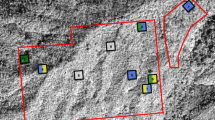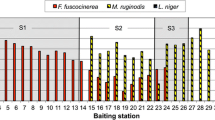Abstract
Two extremely morphologically similar sister species of desert ants, Cataglyphis bicolor and C. savignyi, exhibit broadly overlapping distributional ranges within Tunisia. In order to analyse the microhabitats of C. bicolor and C. savignyi within the sympatric and allopatric areas of both ant species, the plant species located at 113 different nest sites of the two ant species were determined. In the sympatric area, the two species exhibit a clear-cut nest site segregation. This is not the case in the allopatric areas. Hence the two species differentiate their microhabitat only when they are sympatric. The plant species associated mainly with the nest sites of C. bicolor indicate that this species prefers a type of vegetation that needs irrigation. This is in contrast to the nest sites of C. savignyi, which are usually found around plants that characterize typical dry steppe areas. As the ants' foraging paths recorded in the sympatric area reveal, C. bicolor performs significantly shorter foraging runs with respect to both length and time, and covers a much smaller foraging range than C. savignyi does. This result reflects the fact that the microhabitat occupied by the colonies of C. bicolor is richer in food abundance. When direct interspecific interactions were investigated by placing a bait midway between two heterospecific nests, C. bicolor foragers dominated over those of C. savignyi. The same dominance of C. bicolor over C. savignyi occurred in laboratory experiments. These results suggest that the dominant species drives the subordinate one out of the high quality microhabitats, and that the subordinate species is forced to survive in the less lucrative habitats. In conclusion, coexistence seems to be maintained by the asymmetric competitive relationship between the two species and the fact that the subordinate species has the ability to endure in the less favourable microhabitat.






Similar content being viewed by others
References
Albrecht M, Gotelli NJ (2001) Spatial and temporal niche partitioning in grassland ants. Oecologia 126:134–141
Baroni Urbani C, Aktaç N (1981) The competition for food and circadian succession in the ant fauna of a representative Anatolian semi-steppic environment. Mitt Schweiz Entomol Ges 54:33–56
Bernstein RA, Gobbel M (1979) Partitioning of space in communities of ants. J Anim Ecol 48:931–942
Biseau JC de, Quinet Y, Deffernez L, Pasteels JM (1997) Explosive food recruitment as a competitive strategy in the ant Myrmica sabuleti (Hymenoptera, Formicidae). Insect Soc 44:59–73
Braun-Blanquet J (1932) Plant sociology. The study of plant communities. McGraw-Hill, New York
Brian MV (1983) Social insects. Ecology and behavioural biology. Chapman and Hall, London
Campos RBF, Schoereder JH (2001) Dominance and resource temporal partitioning in pasture ants (Hymenoptera : Formicidae). Sociobiology 38:539–550
Cerdá X, Retana J (1998) Interference interactions and nest usurpation between two subordinate ant species. Oecologia 113:577–583
Cerdá X, Retana J, Manzaneda A (1998) The role of competition by dominants and temperature in the foraging of subordinate species in Mediterranean ant communities. Oecologia 117:404-412
Cros S, Retana J, Cerdá X (1997) Spatial and temporal variations in activity patterns of Mediterranean ant communities. Ecoscience 4:267–278
Darwin C (1859) The origin of species. Murray, London
Deffernez L, Champagne P, Verhaeghe JC, Josens G, Loreau M (1990) Analysis of the spatio-temporal niche of foraging grassland ants in the fields. Insect Soc 37:1–13
Dietrich B, Wehner R (1999) Phylogeography of Cataglyphis ants in Tunisia. Proc Dtsch Zool Ges 92:5
Dillier F-X (1998) Räumliche und zeitliche Parameter der Sozialstruktur in Populationen sympatrischer Cataglyphis-Arten (Hymenoptera: Formicidae). PhD thesis. University of Zurich, Zurich
Fellers JH (1989) Daily and seasonal activity in woodland ants. Oecologia 78:69–76
Frankenberg P (1978) Zur pflanzengeographischen Nordgrenze der Sahara in Tunesien. Natur Mus 108:22–25
Gehring WJ, Wehner R (1995) Heatshock protein synthesis in thermotolerance in Cataglyphis, an ant from the Sahara desert. Proc Natl Acad Sci USA 92:2294–2998
Greenslade PJM (1974) Distribution of two forms of meat ant, Iridomyrmex purpureus (Hymenoptera: Formicidae), in parts of South Australia. Aust J Zool 22:489–504
Hölldobler B, Wilson EO (1990) The ants. Springer, Berlin Heidelberg New York
Houerou HN (1969) La vegetaton de la tunisie steppique. INRAT, Ariana, Tunisia
Houerou HN (1995) Bioclimatologie et biogeographie des steppes arides du Nord de l'Afrique. CIHEAM, Montpellier
Houle A (1997) The role of phylogeny and behavioral competition in the evolution of coexistence among primates. Can J Zool 75:827–846
Jancey RC (1979) Species ordering on a variance criterion. Vegetatio 39:59–63
Johnson RA (2000) Habitat segregation based on soil texture and body size in the seed-harvester ants Pogonomyrmex rugosus and P. barbatus. Ecol Entomol 25:403–412
Jones SR, Sherman AP (1990) Resource collecting abilities of Solenopsis invicta (Hymenoptera: Formicidae) compared with those of three sympatric Texas ants. Southwest Nat 35:416–422
Mac Arthur RH (1972) Geographical ecology. Harper and Row, New York
Marsh AC (1988) Activity patterns of some Namib desert ants. J Arid Environ 14:61–73
Mercier JL Dejean A (1996) Ritualized behavior during competition for food between two Formicinae. Insect Soc 43:17–29
Ozenda P (1991) Flore du Sahara. Centre National de la Recherche Scientifique, Paris
Perfecto I (1994) Foraging behavior as a determinant of asymmetric competitive interaction between two ant species in a tropical agroecosystem. Oecologia 98:184–192
Punttila P, Haila Y, Tukia H (1996) Ant communities in taiga clearcuts: habitat effets and species interactions. Ecography 19:16–28
Quezel P, Santa S, Schotter O (1962–1963) Nouvelle flore de l'Algérie et des régions désertiques méridionales. Centre National de la Recherche Scientifique, Paris
Retana J, Cerdá X (1995) Agonistic relationships among sympatric mediterranean ant species (Hymenoptera: Formicidae). J Insect Behav 8:365–380
Retana J, Cerdá X (2000) Patterns of diversity and composition of Mediterranean ground ant communities tracking spatial and temporal variability in the thermal environment. Oecologia 123:436–444.
Ridley M (1996) Evolution. Blackwell, USA
Sanders NJ, Gordon DM (2000) The effects of interspecific interactions on resource use and behavior in a desert ant. Oecologia 125:436–443
Santschi F (1929) Etudes sur les Cataglyphis. Rev Suisse Zool 36:25–70
Savolainen R, Vepsäläinen K (1988) A competition hierarchy among boreal ants: impact on ressource partitioning and community structure. Oikos 51:135–155
Schmid-Hempel P (1983) Foraging ecology and colony structure of two sympatric species of desert ants Cataglyphis bicolor and Cataglyphis albicans. PhD thesis. University of Zurich, Zurich
Schoener TW (1974) Resource partitioning in ecological communities. Science 185:27–39
Traniello JFA (1983) Social organization and foraging success in Lasius neoniger (Hymenoptera: Formicidae): behavioral and ecological aspects of recruitement communication. Oecologia 59:94–100
Traniello JFA (1987) Comparative foraging ecology of north temperate ants: the role of worker size and cooperative foraging in prey selection. Insect Soc 34:118–130
Wehner R (1983) Taxonomie, Funktionsmorphologie und Zoogeographie der saharischen Wüstenameise Cataglyphis fortis (Forel 1902) stat. nov. Senckenberg Biol 64:89–132
Wehner R (1987) Spatial organization of foraging behavior in individually searching ants, Cataglyphis (Sahara Desert) and Ocymyrmex (Namib Desert). In: Pasteels JM, Deneubourg JL (eds) From individual to collective behavior in social insects. Birkhäuser, Basel, pp 15–42
Wehner R, Harkness RD, Schmid-Hempel P (1983) Foraging strategies in individually searching ants Cataglyphis bicolor (Hymenoptera: Formicidae). Fischer, Stuttgart
Wehner R, Marsh AC, Wehner S (1992) Desert ants on a thermal tightrope. Nature 357:586–587
Wehner R, Wehner S, Agosti D (1994) Patterns of biogeographic distribution within the bicolor species group of the North African desert ant, Cataglyphis Foerster 1850. Senckenberg Biol 74:163–191
Wildi O, Orloci L (1996) Numerical exploitation of community patterns. SPB, Amsterdam
Wilson EO (1971) The insect societies. Belknap, Harvard University Press, Cambridge, Mass.
Yamaguchi T (1992) Interspecific interference for nest sites between Leptothorax congruus and Monomorium intrudens. Insect Soc 39:117–127
Acknowledgements
We thank Boukris Elmekki and Cheib Mohamed of the Faculty of Science of the University of Sfax for their help in identifying the plant species, Yvonne Blum for assistance in the field, and the Swiss National Science Foundation (grant no. 31–43317.95) as well as the Roche Research Foundation for financial support.
Author information
Authors and Affiliations
Corresponding author
Rights and permissions
About this article
Cite this article
Dietrich, B., Wehner, R. Sympatry and allopatry in two desert ant sister species: how do Cataglyphis bicolor and C. savignyi coexist?. Oecologia 136, 63–72 (2003). https://doi.org/10.1007/s00442-003-1245-0
Received:
Accepted:
Published:
Issue Date:
DOI: https://doi.org/10.1007/s00442-003-1245-0




